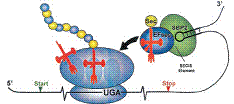Biochemistry, Department of

Vadim Gladyshev Publications
Document Type
Article
Date of this Version
2007
Abstract
Background: Selenocysteine (Sec) is a selenium-containing amino acid that is co-translationally inserted into nascent polypeptides by recoding UGA codons. Selenoproteins occur in both eukaryotes and prokaryotes, but the selenoprotein content of organisms (selenoproteome) is highly variable and some organisms do not utilize Sec at all.
Results: We analyzed the selenoproteomes of several model eukaryotes and detected 26 and 29 selenoprotein genes in the green algae Ostreococcus tauri and Ostreococcus lucimarinus, respectively, five in the social amoebae Dictyostelium discoideum, three in the fly Drosophila pseudoobscura, and 16 in the diatom Thalassiosira pseudonana, including several new selenoproteins. Distinct selenoprotein patterns were verified by metabolic labeling of O. tauri and D. discoideum with 75Se. More than half of the selenoprotein families were shared by unicellular eukaryotes and mammals, consistent with their ancient origin. Further analyses identified massive, independent selenoprotein losses in land plants, fungi, nematodes, insects and some protists. Comparative analyses of selenoprotein-rich and -deficient organisms revealed that aquatic organisms generally have large selenoproteomes, whereas several groups of terrestrial organisms reduced their selenoproteomes through loss of selenoprotein genes and replacement of Sec with cysteine.
Conclusion: Our data suggest many selenoproteins originated at the base of the eukaryotic domain and show that the environment plays an important role in selenoproteome evolution. In particular, aquatic organisms apparently retained and sometimes expanded their selenoproteomes, whereas the selenoproteomes of some terrestrial organisms were reduced or completely lost. These findings suggest a hypothesis that, with the exception of vertebrates, aquatic life supports selenium utilization, whereas terrestrial habitats lead to reduced use of this trace element due to an unknown environmental factor.


Comments
Published in Genome Biology 2007, 8:R198 (doi:10.1186/gb-2007-8-9-r198).